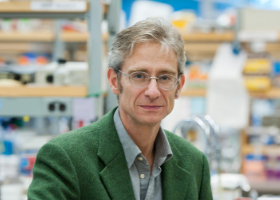
Dr. Fabio Rossi, MD, PhD, University of British Columbia
Finding new ways to repair and maintain muscle function in neuromuscular diseases
Stem cells located in muscle perform two very important functions. First, they are the source of the new muscle fibres needed to repair damage caused by exercise and injury, helping to maintain muscle mass throughout life. Second, muscle stem cells produce copies of themselves to maintain a pool of stem cells that can be called upon for future repair or growth.
As we age, muscle stem cells become fatigued and are unable to rebuild muscle or replenish themselves effectively. Fewer muscle stem cells in the body results in muscle weakness and loss of function, which is why we generally become weaker in later years. However, in the case of neuromuscular disease, which encompasses 150 different disorders affecting the muscle and/or nerves, including various forms of muscular dystrophies, atrophies and myopathies, the depletion of the muscle stem cell pool can occur at any age and can also result in premature death.
More than 50,000 Canadians are living with a neuromuscular disorder. All are considered rare or “orphan” diseases and many are caused by an error or mutation in the genes associated with muscle function. Some can be treated with drugs to reduce the impacts of disease and its progression – the costs can range from $20,000 – $300,000 annually — but most have no treatment and no cure. Finding a reliable approach to expand a person’s muscle stem cell pool could therefore have significant therapeutic benefit, especially in the face of disease.
Attempts to expand the number of muscle stem cells have thus far proved problematic: they either fail to grow in sufficient numbers in the lab, or they change during expansion to the point that they no longer integrate into living muscle tissue, hindering their ability to regenerate damaged muscle. Research has therefore focused on overcoming these hurdles, but a better understanding of the mechanisms that control muscle stem cell expansion in the lab have remained elusive.
Until now.
Stem Cell Network investigator Dr. Fabio Rossi and his team at the University of British Columbia provide the first evidence that a protein known as Setd7 is a critical actor in the pathway that controls the expansion of muscle stem cells. By using a drug that acts on this pathway, Dr. Rossi’s team was able to expand the number of muscle stem cells and show that these cells could improve muscle function when implanted into mouse models of muscular dystrophy. The same drug was also able to improve the expansion of human muscle stem cells, opening the way for future therapeutic applications. Dr. Rossi’s work, published in a 2018 Cell Stem Cell paper, represents a significant breakthrough towards the development of a cell therapy for muscle disease, and was recognized with the 2018 Till & McCulloch Award as the most impactful paper originating from a Canadian stem cell research lab in the past year.
